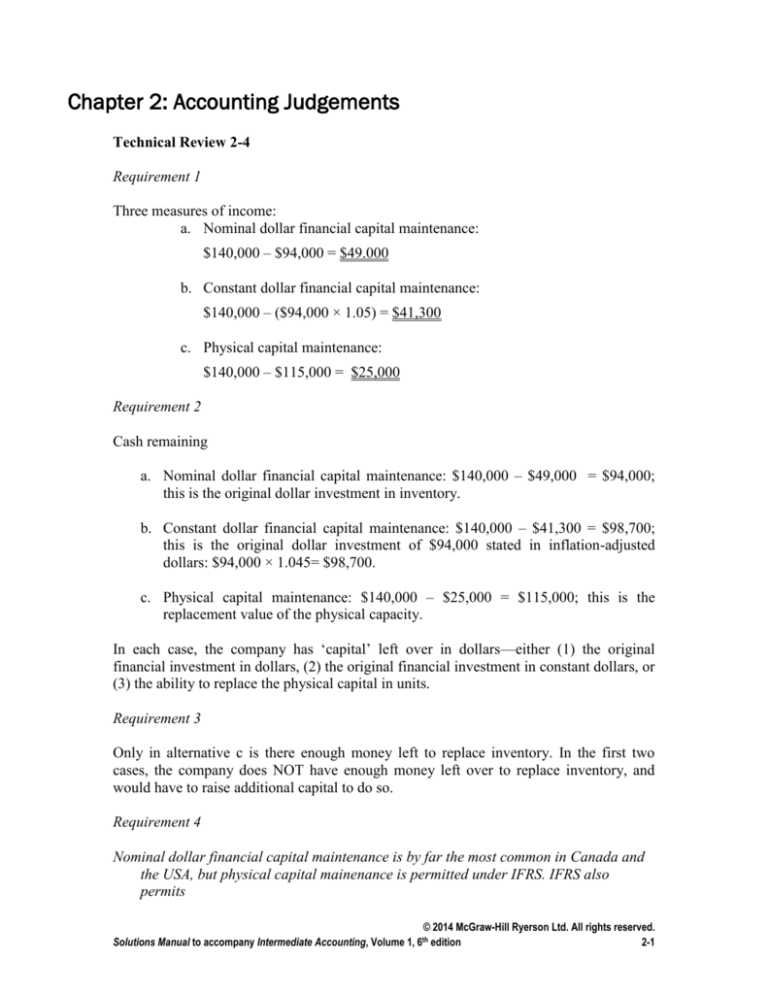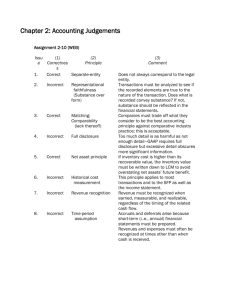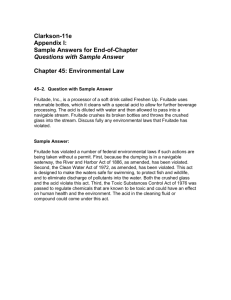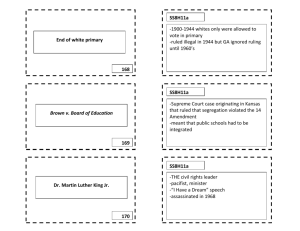
Chapter 2: Accounting Judgements
Technical Review 2-4
Requirement 1
Three measures of income:
a. Nominal dollar financial capital maintenance:
$140,000 – $94,000 = $49.000
b. Constant dollar financial capital maintenance:
$140,000 – ($94,000 × 1.05) = $41,300
c. Physical capital maintenance:
$140,000 – $115,000 = $25,000
Requirement 2
Cash remaining
a. Nominal dollar financial capital maintenance: $140,000 – $49,000 = $94,000;
this is the original dollar investment in inventory.
b. Constant dollar financial capital maintenance: $140,000 – $41,300 = $98,700;
this is the original dollar investment of $94,000 stated in inflation-adjusted
dollars: $94,000 × 1.045= $98,700.
c. Physical capital maintenance: $140,000 – $25,000 = $115,000; this is the
replacement value of the physical capacity.
In each case, the company has ‘capital’ left over in dollars—either (1) the original
financial investment in dollars, (2) the original financial investment in constant dollars, or
(3) the ability to replace the physical capital in units.
Requirement 3
Only in alternative c is there enough money left to replace inventory. In the first two
cases, the company does NOT have enough money left over to replace inventory, and
would have to raise additional capital to do so.
Requirement 4
Nominal dollar financial capital maintenance is by far the most common in Canada and
the USA, but physical capital mainenance is permitted under IFRS. IFRS also
permits
© 2014 McGraw-Hill Ryerson Ltd. All rights reserved.
Solutions Manual to accompany Intermediate Accounting, Volume 1, 6th edition
2-1
Assignment 2-5
1
Issue Correctness
2
Principle
3
Comment
a.
Correct
Separate-entity
It is feasible to separate the financial
affairs of the business from those of the
owner.
b.
Incorrect
Representational
faithfulness
(Substance over
form)
Transactions must be analyzed to see if the
recorded elements are true to the nature of
the transaction. Does a legalistic
presentation of the item convey its
economic substance? If not, substance
should be reflected in the financial
statements rather than the legal form.
c.
Correct
Representational
faithfulness
Matching;
Uniformity
d.
Incorrect
Understandibility
Full disclosure
Companies must trade off what they
consider to be the best accounting
principle to faithfully represents costs
incurred against comparative industry
practice; this is acceptable.
Too much detail is as harmful as not
enough detail—GAAP requires full
disclosure but excessive detail obscures
more significant information.
e.
Correct
Representational
faithfulness
Neutrality
Net asset principle
If inventory cost is higher than its
recoverable value, the inventory value
must be written down to LCM to avoid
overstating net assets’ future benefit.
f.
Incorrect
Historical cost
measurement
This principle applies to most transactions
and to the SFP as well as the income
statement.
g.
Incorrect
Relevance
Time-period
Revenue must be recognized when earned,
measurable, and realizable, regardless of
the timing of the related cash flow.
h.
Incorrect
Time-period
assumption
Accruals and deferrals arise because shortterm (i..e., annual) financial statements
must be prepared. Revenues and expenses
must often be recognized at times other
than when cash is received.
© 2014 McGraw-Hill Ryerson Ltd. All rights reserved.
Solutions Manual to accompany Intermediate Accounting, Volume 1, 6th edition
2-2
i.
Incorrect
Revenue and
matching;
Representational
faithfulness;
Measurement should be free of bias.
Revenues are recognized when earned,
measurable and realizable.
Expenses
should reflect the costs of earning revenue
to obtain an earnings measure that is a
faithful representation of the operating
results of the company. Costs that may not
generate future benefits should be
expensed.
Assignment 2-9
1.
J
2.
E (and G)
3.
K (and B)
4.
M
5.
D
6.
O, F (and K)
7.
H
8.
I, L
9.
C
10. F, A, I
© 2014 McGraw-Hill Ryerson Ltd. All rights reserved.
Solutions Manual to accompany Intermediate Accounting, Volume 1, 6th edition
2-3
Assignment 2-10
Case A:
Consistency and comparability are violated. The accounting information is not
comparable because the depreciation method is inconsistent from period to period.
Case B:
Representational faithfulness is not achieved. The note receivable is not worth its face
value at the time of sale; it is over-valued. The note (and the proceeds received from the
sale) must be shown at the note’s present value: [($55,000 1.21 = $45,455). Using the
present value tables: $55,000 × (P/F, 10%, 2) = $55,000 × 0.82645 = $45,455).
However, if a time period to maturity is short, implicit interest often is ignored as
immaterial.
Case C:
This situation violates relevance and timeliness, even if the information may be more
representationally faithful. The statements are out of date.
Case D:
Revenue recognition is inappropriate. Accrual accounting is usually appropriate.
Case E:
The matching principle is violated. The time period during which the interest is earned is
not properly accounted for. Accrual accounting must be followed.
Case F:
The separate-entity assumption is violated.
Case G:
Full disclosure is violated; also, relevance is likely to be violated.
© 2014 McGraw-Hill Ryerson Ltd. All rights reserved.
Solutions Manual to accompany Intermediate Accounting, Volume 1, 6th edition
2-4
Assignment 2-16
Cash:
The cash should be reported at $313,333; i.e., [$300,000 + ($100,000 ÷ 7.5)] The HK$
must be reported at its Canadian dollar equivalent.
Branford has violated the principle of representational faithfulness, since the $100,000
reported is not an accurate reflection of the value of the cash in a Canadian dollar
financial statement.
Marketable securities:
Marketable securities should be reported at market value (here, $987,000); as
“temporary investments”, they are available-for-sale.
Branford has violated the principle of relevance, since the $900,000 reported cost is
not the most important information with respect to the investment.
Accounts receivable:
The revenue recognition criteria have not been met. The vendor, Branford, has not
performed all acts required—the product has not yet been delivered. The order is an
executory contract at this point and should not be recognized.
Branford has violated the revenue recognition concept. He has also violated the
principle of reliability, since there is no account receivable or revenue until delivery, so
the $500,000 reported is not representationally faithful to its real identity.
Contract liability:
This is an executory contract. There is a contract between Branford and the contractor,
but Branford has not yet paid anything nor has the contractor begun work. This amount
should not be recorded or recognized until at least one party to the contract has
‘executed’ its obligation (or a part thereof).
Other liabilities:
Branford knows that it has an obligation to pay an estimated $75,000 in January 20X7
but has not recorded the liability in the financial statements. The amount should be
recorded.
The reliability of the financial statements is reduced when this liability is omitted.
Branford has violated the principle of representational faithfulness, and also full
disclosure.
© 2014 McGraw-Hill Ryerson Ltd. All rights reserved.
Solutions Manual to accompany Intermediate Accounting, Volume 1, 6th edition
2-5
Assignment 2-19
Case A
The financial statements are not reliable (not free from bias) and do not conform with the
historical cost principle. This is perhaps an attempt to take a ‘big bath’ to protect future
profits; no justification for the write-down is provided.
Case B
The financial statements are not reliable because they are not free from bias.
Management’s excessive conservatism, which is not a virtue, is displayed.
Case C
Comparability is violated in this example. The company is not consistently using a
particular accounting policy nor did they retrospectively restate balances to provide some
consistency. Full disclosure is also violated, as there was no comment or explanation of
the change.
Case D
Representational faithfulness is violated by netting current assets with current liabilities.
The financial statements do not reveal the full extent of the company’s assets and
liabilities. Full disclosure is also violated as a one-line balance sheet does not contain
enough detail. Netting unrelated amounts is not permitted.
Case E
Comparability is in evidence, as promoted by use of uniform accounting policies within
an industry. Since opening balances have not materially changed, retrospective
restatement would not enhance comparability because restatement would not change
financial statements users’ decision – this is the essence of materiality.
© 2014 McGraw-Hill Ryerson Ltd. All rights reserved.
Solutions Manual to accompany Intermediate Accounting, Volume 1, 6th edition
2-6





